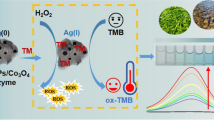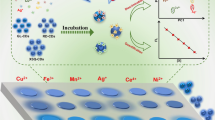Abstract
We report a simple, facile, and reliable colorimetric system for detection of chromium(III) ions (Cr3+) using citrate- and thiourea-modified gold nanoparticles (AuNPs). The colorimetric sensing strategy is based on the synergistic coordination interaction of citrate and thiourea toward Cr3+ on the surface of AuNPs, leading to the aggregation of AuNPs which produces a color change from red to purple. Under the optimal conditions, this colorimetric sensing system shows an excellent selectivity and sensitivity for Cr3+, and the limit of detection (LOD) is estimated to be 0.05 μM at a signal-to-noise ratio of 3, which is far below the current standard stipulated by U.S. Environmental Protection Agency (1.9 μM). Moreover, this LOD is one and a half orders of magnitude lower than those of previously reported modified AuNPs-based colorimetric methods. Visual color change can be observed when 50 μM of Cr3+ was introduced to the sensing system. Furthermore, this colorimetric sensing system can be employed for detection of Cr3+ in diluted natural water samples.





Similar content being viewed by others
References
Zeng S, Yong K, Roy I, Dinh X, Yu X, Luan F. A review on functionalized gold nanoparticles for biosensing applications. Plasmonics. 2011;6(3):491–506.
Jung J, Lee J, Shinkai S. Functionalized magnetic nanoparticles as chemosensors and adsorbents for toxic metal ions in environmental and biological fields. Chem Soc Rev. 2011;40(9):4464–74.
Hughes S, Dasary S, Singh A, Glenn Z, Jamison H, Ray P, et al. Sensitive and selective detection of trivalent chromium using hyper Rayleigh scattering with 5, 5′-dithio-bis-(2-nitrobenzoic acid)-modified gold nanoparticles. Sens Actuator B Chem. 2013;178:514–9.
Chen W, Lin S, Liu C. Capillary electrochromatographic separation of metal ion species with on-line detection by inductively coupled plasma mass spectrometry. Anal Chim Acta. 2000;410(1):25–35.
Ghaedi M, Shokrollahi A, Kianfar A, Mirsadeghi A, Pourfarokhi A, Soylak M. The determination of some heavy metals in food samples by flame atomic absorption spectrometry after their separation-preconcentration on bis salicyl aldehyde, 1, 3 propan diimine (BSPDI) loaded on activated carbon. J Hazard Mater. 2008;154(1):128–34.
Lafleur J, Salin E. Speciation of chromium by high-performance thin-layer chromatography with direct determination by laser ablation inductively coupled plasma mass spectrometry. Anal Chem. 2008;80(17):6821–3.
Yang W, Zhang Z, Deng W. Simultaneous, sensitive and selective on-line chemiluminescence determination of Cr (III) and Cr (VI) by capillary electrophoresis. Anal Chim Acta. 2003;485(2):169–77.
Mahato P, Saha S, Suresh E, Liddo R, Parnigotto P, Conconi M, et al. Ratiometric detection of Cr3+ and Hg2+ by a naphthalimide-rhodamine based fluorescent probe, Inor. Chem. 2012;51(3):1769–77.
Li Y, Xue H. Determination of Cr (III) and Cr (VI) species in natural waters by catalytic cathodic stripping voltammetry. Anal Chim Acta. 2001;448(1):121–34.
Chai F, Wang C, Wang T, Li L, Su Z. Colorimetric detection of Pb2+ using glutathione functionalized gold nanoparticles. ACS Appl Mater Interf. 2010;2(5):1466–70.
Liu S, Lu F, Zhu J. Highly fluorescent Ag nanoclusters: microwave-assisted green synthesis and Cr3+ sensing. Chem Commun. 2011;47(9):2661–3.
Liu B, Tan H, Chen Y. Upconversion nanoparticle-based fluorescence resonance energy transfer assay for Cr (III) ions in urine. Anal Chim Acta. 2013;761:178–85.
Saha K, Agasti S, Kim C, Li X, Rotello V. Gold nanoparticles in chemical and biological sensing. Chem Rev. 2012;112(5):2739–379.
Chen Y, Lee I, Sung Y, Wu S. Triazole functionalized gold nanoparticles for colorimetric Cr3+ sensing. Sens Actuator B Chem. 2013;188:354–9.
Dang Y, Li H, Wang B, Li L, Wu Y. Selective detection of trace Cr3+ in aqueous solution by using 5, 5′-dithiobis (2-nitrobenzoic acid)-modified gold nanoparticles. ACS Appl Mater Interf. 2009;1(7):1533–8.
Jin W, Huang P, Chen Y, Wu F, Wan Y. Colorimetric detection of Cr3+ using gold nanoparticles functionalized with 4-amino hippuric acid. J Nanopart Res. 2015;17(9):1–10.
Xin J, Miao L, Chen S, Wu A. Colorimetric detection of Cr3+ using tripolyphosphate modified gold nanoparticles in aqueous solutions. Anal Methods. 2012;4(5):1259–64.
Li J, Han C, Wu W, Zhang S, Guo J, Zhou H. Selective and cyclic detection of Cr3+ using poly (methylacrylic acid) monolayer protected gold nanoparticles. N J Chem. 2014;38(2):717–22.
Frey S, Gong M, Horrocks Jr W. Synergistic coordination in ternary complexes of Eu3+ with aromatic. Beta.-Diketone Ligands and 1, 10-Phenanthroline, Inor. Chem. 1994;33(15):3229–34.
Lee J, Park J, Lah M, Chin J, Hong J. High-affinity pyrophosphate receptor by a synergistic effect between metal coordination and hydrogen bonding in water. Org Lett. 2007;9(19):3729–31.
He Y, Cui H. Label free and homogeneous histone sensing based on chemiluminescence resonance energy transfer between lucigenin and gold nanoparticles. Biosens Bioelectron. 2013;47:313–7.
He Y, Zhang X, Yu H. Gold nanoparticles-based colorimetric and visual creatinine assay. Microchim Acta. 2015;182(11–12):2037–43.
Ye Y, Liu H, Yang L, Liu J. Sensitive and selective SERS probe for trivalent chromium detection using citrate attached gold nanoparticles. Nanoscale. 2012;4(20):6442–8.
Hamada Y, Cox R, Hamada H. Cu2+-citrate dimer complexes in aqueous solutions. Journal of Basic &Appl Sci. 2015;11:583–9.
Wang H, He F, Yan R, Wang X, Zhu X, Li L. Citrate-induced aggregation of conjugated polyelectrolytes for Al3+-ion-sensing assays. ACS Appl Mater Interf. 2013;5(16):8254–9.
Pekel N, Savaş H, Güven O. Complex formation and adsorption of V3+, Cr3+ and Fe3+ ions with poly (N-vinylimidazole). Colloid Poly Sci. 2002;280(1):46–51.
Abdlseed F, El-ajaily M. Complex formation of TiO (IV), Cr (III) and Pb (II) ions using 1, 3-bis (2-hydroxybenzylidene) thiourea as ligand, Inter. J Res Pharm Biomed Sci. 2012;3(3):1031–7.
Li J, Han C, Wu W, Zhang S, Guo J, Zhou H. Selective and cyclic detection of Cr3+ using poly (methylacrylic acid) monolayer protected gold nanoparticles. New J Chem. 2014;38:717–22.
Singh A, Kaur S, Kaur A, Aree T, Kaur N, Singh N, et al. Aqueous-phase synthesis of copper nanoparticles using organic nanoparticles: application of assembly in detection of Cr3+. ACS Sustain Chem Eng. 2014;2(4):982–90.
Dhara A, Guchhait N, Kar S. A novel Cr3+ fluorescence turn-on probe based on rhodamine and isatin framework. J Fluoresc. 2015;25(6):1921–9.
Acknowledgments
The support of this research by the Undergraduate Innovation Fund Project of Southwest University of Science and Technology (Grant No. CX16-096), Foundation of Science and Technology Department of Sichuan Province (Grant No. 2015JY0053), and Teaching Reform Project of Southwest University of Science and Technology (Grant No. 16xn0022) is gratefully acknowledged.
Author information
Authors and Affiliations
Corresponding author
Ethics declarations
Conflict of interest
The authors declare that they have no conflict of interest.
Electronic supplementary material
Below is the link to the electronic supplementary material.
ESM 1
(PDF 792 kb)
Rights and permissions
About this article
Cite this article
Long, D., Yu, H. A synergistic coordination strategy for colorimetric sensing of chromium(III) ions using gold nanoparticles. Anal Bioanal Chem 408, 8551–8557 (2016). https://doi.org/10.1007/s00216-016-9990-1
Received:
Revised:
Accepted:
Published:
Issue Date:
DOI: https://doi.org/10.1007/s00216-016-9990-1




